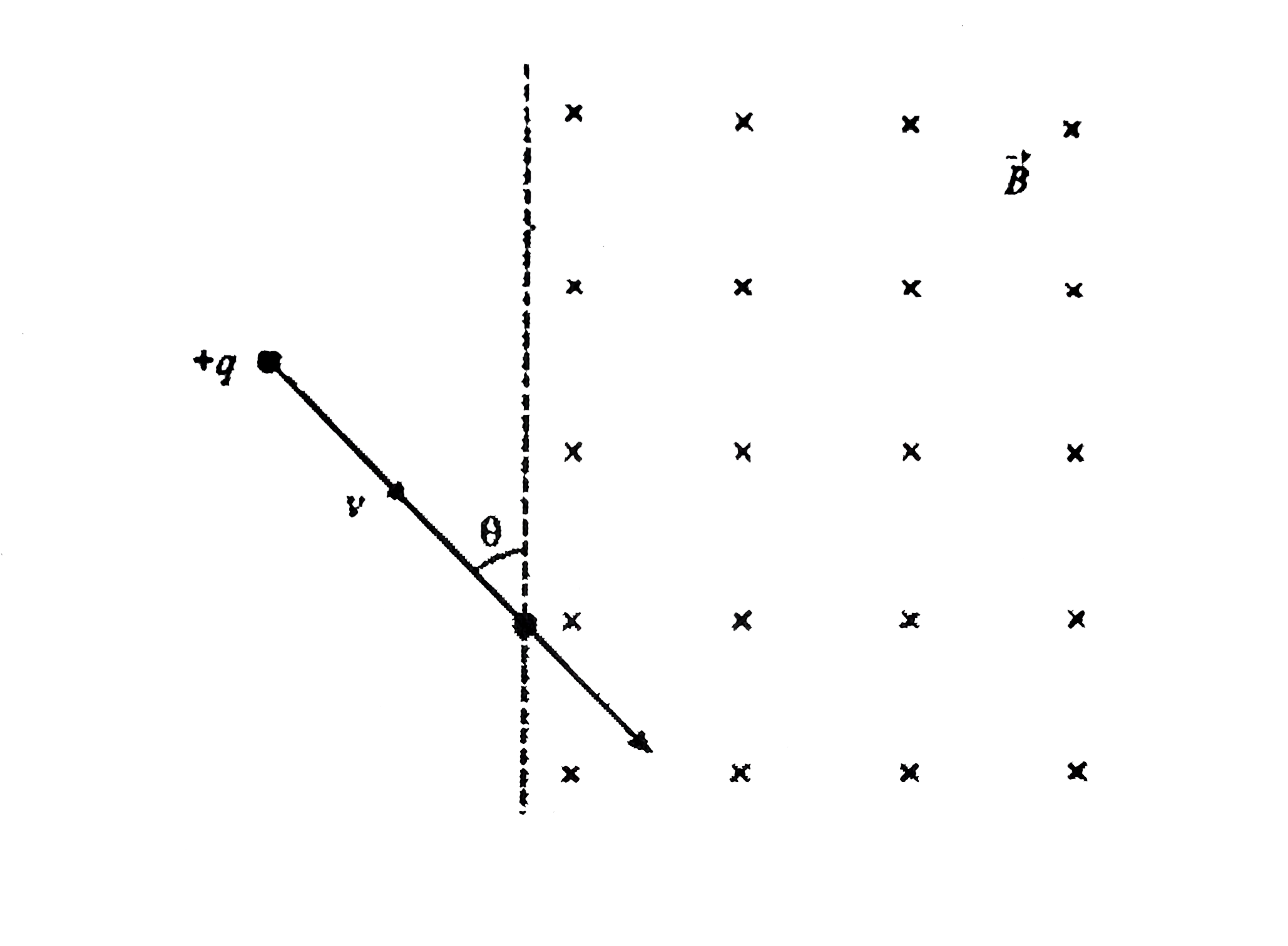A particle of mass m carrying charge q is accelerated by a potential difference V. It enters perpendicularly in a region of uniform magnetic field B and executes circular arc of radius R, then qm equals
2VB2R2
V2BR
VB2R
mVBR
The correct Answer is:A
To solve the problem, we need to find the ratio qm for a charged particle of mass m and charge q that is accelerated by a potential difference V and enters a magnetic field B perpendicularly, executing a circular arc of radius R.
1. Understanding the Forces:
When a charged particle enters a magnetic field perpendicularly, it experiences a magnetic force given by the Lorentz force formula:
F=qvB
where v is the velocity of the particle and B is the magnetic field strength.
2. Centripetal Force:
The particle moves in a circular path, so the magnetic force acts as the centripetal force. The centripetal force required to keep the particle moving in a circle of radius R is given by:
F=mv2R
3. Setting the Forces Equal:
Since the magnetic force provides the centripetal force, we can set them equal to each other:
qvB=mv2R
4. Rearranging the Equation:
We can rearrange this equation to express qm:
qvB=mv2R⟹q=mv2RvB
Dividing both sides by m:
qm=vRB
5. Finding Velocity from Potential Difference:
The particle is accelerated by a potential difference V. The kinetic energy gained by the particle is equal to the work done on it by the electric field:
qV=12mv2
Rearranging this gives:
v2=2qVm
6. Substituting Velocity into the Ratio:
Now we substitute v2 back into our expression for qm:
qm=vRB=√2qVmRB
7. Squaring Both Sides:
To eliminate the square root, we square both sides:
(qm)2=2qVmR2B2
8. Final Expression for qm:
Rearranging gives:
qm=2VR2B2
Conclusion:
Thus, the final result for the ratio qm is:
qm=2VR2B2
When a charged particle enters a magnetic field perpendicularly, it experiences a magnetic force given by the Lorentz force formula:
F=qvB
where v is the velocity of the particle and B is the magnetic field strength.
The particle moves in a circular path, so the magnetic force acts as the centripetal force. The centripetal force required to keep the particle moving in a circle of radius R is given by:
F=mv2R
Since the magnetic force provides the centripetal force, we can set them equal to each other:
qvB=mv2R
We can rearrange this equation to express qm:
qvB=mv2R⟹q=mv2RvB
Dividing both sides by m:
qm=vRB
The particle is accelerated by a potential difference V. The kinetic energy gained by the particle is equal to the work done on it by the electric field:
qV=12mv2
Rearranging this gives:
v2=2qVm
Now we substitute v2 back into our expression for qm:
qm=vRB=√2qVmRB
To eliminate the square root, we square both sides:
(qm)2=2qVmR2B2
Rearranging gives:
qm=2VR2B2
Thus, the final result for the ratio qm is:
qm=2VR2B2
Topper's Solved these Questions
- MOVING CHARGE AND MAGNESIUMBOOK - AAKASH INSTITUTECHAPTER - MOVING CHARGE AND MAGNESIUMEXERCISE - SECTION B
25 Videos
- MOVING CHARGE AND MAGNESIUMBOOK - AAKASH INSTITUTECHAPTER - MOVING CHARGE AND MAGNESIUMEXERCISE - SECTION C
48 Videos
- MOVING CHARGE AND MAGNESIUMBOOK - AAKASH INSTITUTECHAPTER - MOVING CHARGE AND MAGNESIUMEXERCISE - EXERCISE
30 Videos
- MOTION IN STRAIGHT LINEBOOK - AAKASH INSTITUTECHAPTER - MOTION IN STRAIGHT LINEEXERCISE - Assignment (SECTION - J)
2 Videos
- MOVING CHARGES AND MAGNETISMBOOK - AAKASH INSTITUTECHAPTER - MOVING CHARGES AND MAGNETISMEXERCISE - Assignment Section J (Aakash Challengers Questions)
5 Videos
Similar Questions
A charged particle of mass m and charge q is accelerated through a potential difference of V volts. It enters a region of uniform magnetic field which is directed perpendicular to the direction of motion of the particle. Find the radius of circular path moved by the particle in magnetic field.
View SolutionA charge particle of mass m and charge q is accelerated by a potential difference V volt. It enters in a region of uniform magnetic field Bas shown in figure-4.93. Find the time after which it will come out from the magnetic field.

View Solution
Knowledge Check
A particle of mass 'm' and charge 'q' is accelerated through a potential difference of V volt, its energy will be
AqVBmqVC(qm)VDqmVA particle of mass 'm' and charge 'q' is accelerated through a potential difference of V volt, its energy will be
AqVBmqVC(qm)VDqmVTwo particles X and Y having equal charges, after being accelerated through the same potential difference, enter a region of uniform magnetic field and describe circular path of radius R1 and R2 respectively. The ratio of mass of X to that of Y is :
A1BR2R1C(R1R2)2D2
Two particles X and Y having equal charges, after being accelerated through the same potential difference, enter a region of uniform magnetic field and describes circular path of radius R1, and R2, respectively. The ratio of mass of X to that of Y is
View SolutionTwo particle X and Y having equal charges, after being accelerated through the same potential differences, enter a region of uniform magnetic field B and describe circular paths of radii R1andR2 respectively . The ratio of mass of X to that of Y is
View SolutionA charged particle of mass m and charge q is accelerated through a potential differences of V volts. It enters of uniform magnetic field B which is directed perpendicular to the direction of motion of the particle. The particle will move on a circular path of radius
View SolutionTwo particle X and Y having equal charge, after being accelerated through the same potential difference enter a region of uniform magnetic field and describe circular paths of radii R1andR2 respectively. The ratio of the mass of X to that of Y is
View SolutionTwo particles X and Y having equal charges, after being accelerated through the same potential difference, enter a region of uniform magnetic field and describe circular paths of radii R1andR2, respectively. The ratio of masses of X and Y is
View Solution
